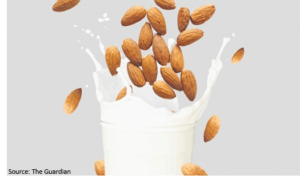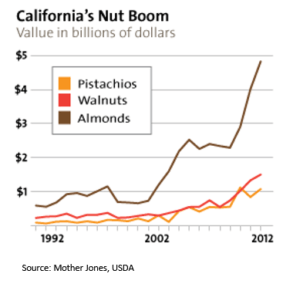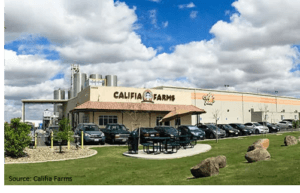Califia Farms: Cracking the Drought in California

Having reinvented almond milk, Califia is one of the fastest growing beverage brands in the world. But is it helping run California dry?
There’s a modern-day gold rush happening in California, but this one doesn’t glitter. Driven by increased health consciousness and oft-cited health studies, Americans are “consuming more than 10 times as many almonds as [they] did in 1965” (1). And they’re not just eating almonds by the handful – they’re pouring them over their cereal and into their coffee.
Meet Califia Farms, the Los Angeles-based new kid on the block that has helped make almond milk cool and given WhiteWave’s Silk and Blue Diamond’s Almond Breeze a run for their money. Founded in 2010 by Greg Steltenpohl, the entrepreneur behind Odwalla, Califia, with its distinctive rounded jugs and wholesome branding, has grown rapidly, reaching 27,000 storefronts in the U.S., and has gained industry recognition, winning BevNet’s 2015 Brand of the Year and Beverage World’s 2015 “Breakout Brand” (2).
 Califia started with citrus juices and has expanded into ready-to-drink coffee beverages, but its core product is its almond milk, which tripled in revenue in 2014 (3) and “experienced triple digit growth [in 2015]…accounting for 75%” of the growth of the overall almond milk category (2). Since 2010, that category has itself grown from 10% to 65% of the roughly billion dollar nondairy milk substitutes market, dethroning soy milk, long embittered by health concerns (4).
Califia started with citrus juices and has expanded into ready-to-drink coffee beverages, but its core product is its almond milk, which tripled in revenue in 2014 (3) and “experienced triple digit growth [in 2015]…accounting for 75%” of the growth of the overall almond milk category (2). Since 2010, that category has itself grown from 10% to 65% of the roughly billion dollar nondairy milk substitutes market, dethroning soy milk, long embittered by health concerns (4).
 Given its Mediterranean climate, ideal for harvesting almonds, California produces almost the entirety of the U.S. almond supply, and comprises 82% of the global supply (1). California almond farmers are keeping pace with the demand and cashing in, with land devoted to almond production doubling and overall crop value growing at an 11% CAGR since 1995 (5). Almonds are big business, with industry revenues in California of $11bn (6), of which $4.5bn is exports, primarily to China (7).
Given its Mediterranean climate, ideal for harvesting almonds, California produces almost the entirety of the U.S. almond supply, and comprises 82% of the global supply (1). California almond farmers are keeping pace with the demand and cashing in, with land devoted to almond production doubling and overall crop value growing at an 11% CAGR since 1995 (5). Almonds are big business, with industry revenues in California of $11bn (6), of which $4.5bn is exports, primarily to China (7).
But all is not well in the goldmine. California is in “its fifth year of severe drought” with “2015 as the warmest year on record” (8). The severity of the drought caused Governor Jerry Brown to declare a state of emergency in 2014, enacting residential and commercial water use restrictions. These restrictions were renewed in 2016, and drought conditions are expected to persist (8). Given a single almond requires an average of 1.3 gallons of water to produce (9), and almond production in California contributes roughly 10% of the state’s annual water usage (10), the almond rush will not be able to continue unchecked.
The amount of water required to produce a single almond and the fact that almonds are the state’s largest export have made them an easy scapegoat for California’s crisis. Skeptics point out however, that almonds’ water requirement is comparable to other crops, and in fact less than that required to produce cow’s milk (10). The issue is one of timing.
Unlike “row” crops such as tomatoes, which can be left fallow in a dry year, almond trees are permanent (11) and “must be watered even when they’re not producing…farmers are locking in future water use for decades to come” (10) in areas of the state where “water shortages are most severe” (11). As global climate change and California’s drought continue, almond growers risk further restrictions  on their water supplies, but can’t simply relocate their trees.
on their water supplies, but can’t simply relocate their trees.
Califia Farms has built its brand on an input that will become increasingly expensive and limited as climate change continues to put pressure on California’s water supply, but the company has made sustainability a core component of its message. When it comes to its own production process, Califia repurposes over 90% of its post-production byproduct (mostly water) for irrigation on farms near its facility, and has reduced water usage at its production plant by 64% from ’15 to ’16 (12). While admirable, these improvements pale in comparison to the environmental impact of the upstream almond production Califia relies on. To address this, the company has made sure to partner with growers that use drip-irrigation methods (only 30% of growers still use high-volume flood irrigation (7)) and active soil monitoring to reduce water usage (12).
As an innovator at the forefront of the plant-based beverage space, and one whose brand depends on almonds, Califia must do more. Incremental efficiencies will not change the fact that almonds are becoming an unsustainably large part of California’s agricultural complex and resource use. “High-input, mono-crop agriculture [is] a ‘key driver of and major victim of global warming” (13), and the solution lies in agricultural diversification.
Califia has turned almonds into gold, but to be a sustainable company, it must now leverage its know-how and powerful brand to find and market the next plant-based milk, reducing reliance on almonds. Let’s just hope it tastes as good.
[Word Count: 780]
References
- James Hamblin, “The Dark Side of Almond Use,” The Atlantic, August 28, 2014, http://www.theatlantic.com/health/archive/2014/08/almonds-demon-nuts/379244/, accessed November 2016.
- “Califia Farms Doubles Bakersfield, CA Operations to Support Growth, Innovation, and Customer Service,” press release, May 4, 2016, on PR Web, http://www.prweb.com/releases/2016/05/prweb13382806.htm, accessed November 2016.
- “Califia Farms Named 2015 Brand of the Year by BevNet,” press release, December 14, 2015, on PR Web, http://www.prweb.com/releases/2015/12/prweb13127969.htm, accessed November 2016.
- Ryan McCormack, “Soy & Almond Milk Production in the US,” July 2016, via IBISWorld, accessed November 2016.
- United States Department of Agriculture, National Agricultural Statistics Service, April 29, 2016, https://www.nass.usda.gov/Statistics_by_Subject/?sector=CROPS, accessed November 2016
- Daniel Sumner, William Matthews, Josue Medellin-Azuara, Adrienne Bradley, “The Economic Impacts of the California Almond Industry,” 2014, University of California Agriculture Issues Center, http://www.almonds.com/sites/default/files/content/attachments/the_economic_impacts_of_the_california_almond_industry.pdf, accessed November 2016.
- Almond Board of California, “Almond Almanac 2015,” 2015, http://www.almonds.com/sites/default/files/content/attachments/2015_almanac.pdf, accessed November 2016.
- S. Geological Service, California Water Science Center, “California Drought,” http://ca.water.usgs.gov/data/drought/, accessed November 2016.
- Jo Craven McGinty, “The Numbers Behind Agricultural Water Use,” The Wall Street Journal, June 21, 2015, http://www.wsj.com/articles/the-numbers-behind-agricultural-water-use-1434726353, accessed November 2016.
- Eric Holthaus, “Stop Vilifying Almonds,” Slate, in Moneybox blog, April 17, 2015, http://www.slate.com/articles/business/moneybox/2015/04/almonds_in_california_they_use_up_a_lot_of_water_but_they_deserve_a_place.html, accessed November 2016.
- Dale Kasler, “California Almond Farmers, Lured by High Profits to Expand Orchards, Face a Drought Struggle,” The Sacramento Bee, May 11, 2014, http://www.sacbee.com/news/local/article2598507.html, accessed November 2016.
- Califia Farms, “FAQs,” https://www.califiafarms.com/faqs, accessed November 2016.
- Dana Goodyear, “What Milk Should I Drink?,” The New Yorker, October 23, 2015, http://www.newyorker.com/news/daily-comment/what-milk-should-i-drink, accessed November 2016.
Images and Figures
- Cover Image of Desert, “California Drought Emergency Declared by Governor Jerry Brown,” Huffington Post, January 25, 2014, http://i.huffpost.com/gen/1569133/images/o-CALIFORNIA-DROUGHT-facebook.jpg, accessed November 2016.
- Cover Image of Califia Farms Almond Milk, http://static1.squarespace.com/static/542758dbe4b0b8d209da4e1e/t/54ae2974e4b061eb98d49e57/1420700030906/, accessed November 2016.
- Emine Saner, “Almond Milk: Quite Good for you – Very Bad for the Planet,” The Guardian, October 21, 2015, https://www.theguardian.com/lifeandstyle/shortcuts/2015/oct/21/almond-milk-quite-good-for-you-very-bad-for-the-planet, accessed November 2016.
- Julia Lurie, “California’s Almonds Suck as Much Water Annually as Los Angeles Uses in Three Years,” Mother Jones, January 12, 2015, blog, http://www.motherjones.com/environment/2015/01/almonds-nuts-crazy-stats-charts, accessed November 2016.
- Alissa Walker, “Seriously, Stop Demonizing Almonds,” Gizmodo, April 8, 2015, blog, http://gizmodo.com/seriously-stop-demonizing-almonds-1696065939, accessed November 2016.
- Almond Board of California, USDA, “Almond Crunch: California Drought Withers World Supply,” MarketWatch, March 11, 2014, http://www.marketwatch.com/story/almond-crunch-california-drought-withers-world-supply-2014-03-11, accessed November 2016.
- Califia Farms, “About Us,” https://www.califiafarms.com/about-us, accessed November 2016.



Dan – enlightening post about the impact of a health-based business on climate change. The fact that almonds consume 10% of California’s water supply is staggering. I think you’re right on in your suggestions. All things almond have begun a craze, but mono-crop farming isn’t sustainable. The reality is that quality dairy substitutes can be made from any nut or plant-based fat (avocados, coconuts). Califia needs to expand to be the brand to be focused on all plant-based alternatives, not just almonds! In any event, the impact of almond production is still not as bad as that of cows and dairy production.
Dan, terrific post on an issue that will be an ongoing concern, particularly as the health craze (and increased almond milk consumption) for millenials continues. Califia along with other almond milk producers will need to find ways to be more sustainable. A few questions jumped out at me as I read through your post: (1) What has Califia’s inventory management looked like? Is there a way for them to reduce their production amount while still satisfying forecasted demand? (2) How does Califia’s sustainability compare to other almond milk producers, as well as their water usage metrics? (3) What type of precision agriculture technologies are they using to monitor soil moisture and are these effective (depending on the environment and type – physical sensors v remote sensors via drones – efficacy can vary)? Despite how much water Califia is using for its almond production, I will say your post as well as other news sources suggest that water usage for almonds is very efficient — unlike that dairy industry where it takes 110 gallons of water to produce 1 hamburger. Califia seems to be working toward a more sustainable model, and unless almond production is challenged by more efficient plant based production or a move into more urban areas, I think it’s safe to say the gold rush will continue in California.
Dan – I thought your post did a great job summarizing the issues facing California not only at a broader agricultural level, but also within a more specific industry. Your points about the difference between almond trees and traditional row crops are key to understanding the longer-term effects on the water table in California. I actually worked on a deal with Califia in my last job, and they made a huge show of their sustainability in terms of climate change, etc. because they don’t have the same environmental impact as cows (methane, etc.) but provide a milk alternative. They were extremely careful in their avoidance of discussing the water crisis and their effect on the water table and the availability of fresh water in California, I believe because they are well aware of these issues but not taking much substantial action to address them. You do a good job laying out why they need to take action, and why their ownership of the issue is key for any potential solution.
Dan – what an interesting and exciting pocket within the relatively steady and staple milk industry. I understand that even though water is the most abundant resource on the planet, there are areas in the world, such as CA, that have limited access to fresh water. Given that Califa has established a brand and is leading the almond milk category in terms of growth, why can’t they begin to plant trees in other regions of the world where fresh water is more plentiful? It seems to me that they could reduce the stress on CA’s water supply by beginning to plant seeds (literally) in other regions. I wonder if they will begin to do so in the coming years as this issue intensifies.
Dan – Awesome post on a Califia, the industry, and the California drought. Placing myself in the shoes of the management team, I’m wondering 1) did they foresee this issue early on? If so, how could they have hedged it either through a different product mix or operational efficiency with less water and other raw materials? 2) How are competitors responding to this change (unless they’re coming from a different region)? 3) Are there ways to “arbitrage” the water situation by either transporting or moving productions to another region where water is abundant?
Overall, thanks for the post and excited to see where this company goes!
Dan, good to have some almond-interested company! I see that you point out that Califia is currently focusing on encouraging responsible irrigation methods like drip and soil-monitored irrigation. However, they are also (1) working to limit the water use in their manufacturing process with a 64% per-unit reduction in water usage over the last year; and (2) they ensure that 100% of their processed water is reused by local businesses near their San Joaquin Valley headquarters. I actually think these measures taken together make them one of the most responsible dairy/dairy substitute companies out there.
However, I am still intrigued by your inclination that they must innovate laterally as opposed to focusing on what you call “incremental efficiencies”. While technology can create step-function change in the space, is Califia the right organization to be investing in hit-or-miss solutions?
(Source for my stats: https://www.califiafarms.com/faqs)